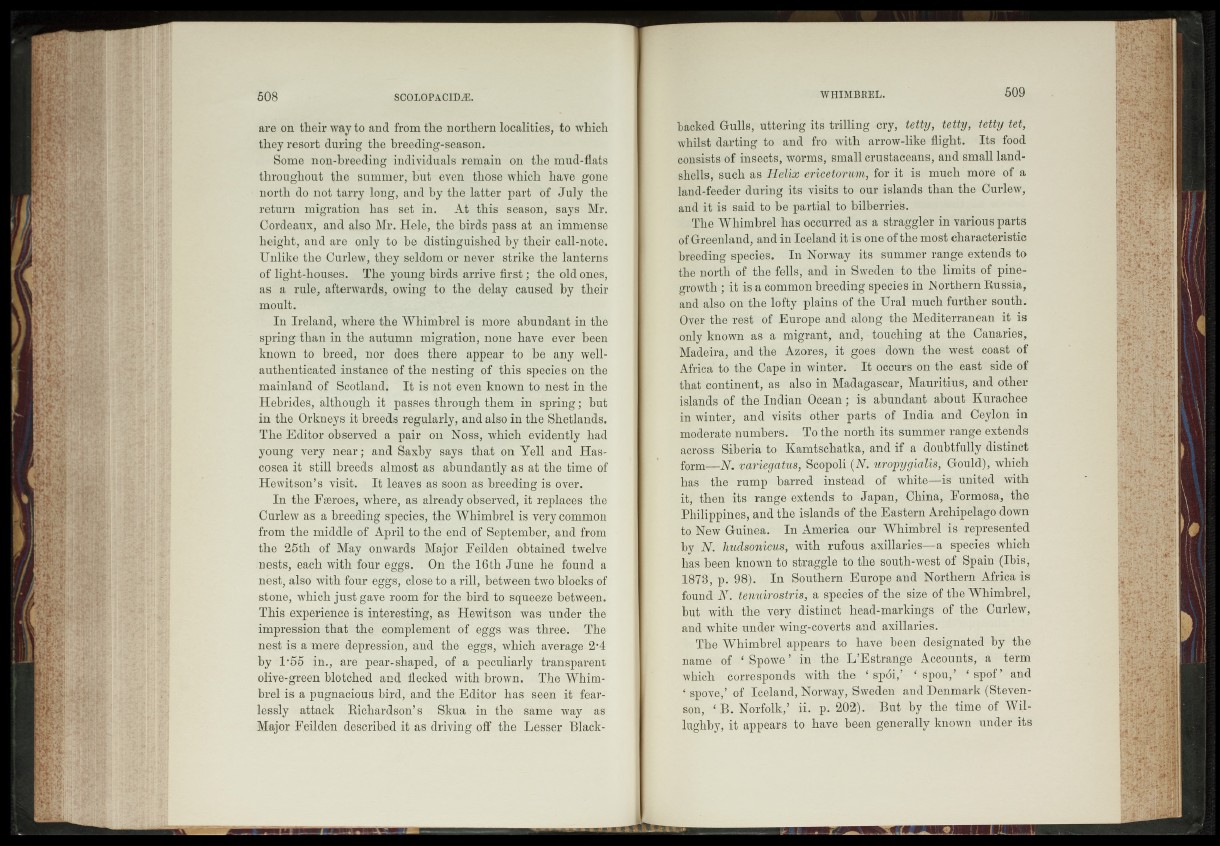
are on their way to and from the northern localities, to which
they resort during the breeding-season.
Some non-breeding individuals remain on the mud-flats
throughout the summer, hut even those which have gone
north do not tarry long, and by the latter part of July* the
return migration has set in. At this season, says Mr.
Cordeaux, and also Mr. Hele, the birds pass at an immense
height, and are only to he distinguished by their call-note.
Unlike the Curley, they seldom or never strike the lanterns
of light-houses.. The young birds arrive first; 'the old ones,
as a rule, afterwards, owing to. the delay caused by their
moult.
In Ireland, where the Whimbrel is ;more abundant in the
spring-than in the autumn migration, none have ever been
known to breed, nor does there • appear to be any ^ell-
authenticated instancy of the nesting »'of’this species on the
mainland of Scotland; It is not-'even'known to; nest in the
Hebrides, although it passes through them? infsnpng; b it
in the. Orkneys it breed,$ regularly, and also in the Shetlands.
The Editor observed a pair on ^oss,yhich evidently had
young very near ; and Saxby says ’ that en. xfelt-and Has-
cosea it still breeds almost as abundantly as at tEe time' ©f
Hewitson’s visit?-*, It leaves asfa©hn' as breeding is over.
In the Faeroes, where, as already'ibseryed, it replaces the
Curlew as a breeding species,- the Whimbrel is very comjnoh
from the middle of April to the'end of, September, and fSjb
the 25th of May onwards 'Major ?FeiMen obtained twelve
meats, each-with four eggs’, On thertBth JuUeriae; fbun'd a
nest, also with four eggs, close to a rill, between tw6'blocks If
stone, which just gave room for the^biiid'to squeeze between.
This experience is interesting, as Hewitsbm was under the
-impression that, the complement of?eggs fwas -three.*>' ’ The
nest is a mere depression, aiidiithe^eggs, ’Which-^average!2’ri
§ P P | 'in., nre pearrshaped, of at peculiarly transparent
»Evergreen blotched andtfieoked with brown. f-SCbeWhim-
ferel is a pugnacious bird, and Ithe Editor hast1 ^een it''fearlessly
attack .lEichardson’s « Skua..in: the same? way as
■Major Feilden'. describefiririas drivinoffvthe Lesser Blackbacked
Gulls, uttering its trilling cry, i tetty, tettytetty te%
whilst darting to and fro with arrow-like flight. Its food
consists of insects, worms, small crustaceans, and small land*
shells,; such as Helix erieetbrum; for it if - much more of a
land-feeder .during its*-visits to our islands than the Curlew,
and it is said to be partial t©*bilberries.
#^Ehe Whimbrel has occurred as a straggler in various parts
©ffGreenland, andin Iceland it isSçüe of the most characteristic
breeding species. In Norway # s summer range extends to
themertK of the-fëtls^and in^weden- toithfe limits* of -pine-
growth ;^ é s a commonhreeding speerès in Northern Russia,1
and also on the lofty plains of the Ural much further south.
Over the-vest "ófr Europe- and *afo’ngs;the Mediterranean it is
only known as- a migrant,- and, - touching *t the.- Canaries,
Madeira, and the Azor-es^it goes jj down the west coast of
Africa to the: Cape in winter; * ’I t occurs on the east side of
thât continent, as afeorin Madagascar; Mauritius; and other
islands of the Indian Ocean- ; is abundant-'about- Kurachee
intwinter, and visits iother- parts- of India and Ceylon in
m©d'erat,eJbdnib^s .i To the‘.northits summer rahge extends
across« Siberia: to- Kamtschatka, and if a doubtfully distinct’
Scsjfoli;^W;a‘mèopy'giaUs-, Gould);-which
has the-rump-barred instead - of whiteri4i| united" with
it; then :its : rangé .extends to-Japan, China, Formosa, the
Philippines, and the islands of the^Eastern Archipelago down
topTW-Guinea.: In America; our Whimbrel is represented
by„;ÎM.' hud&nicusf ^ itK rufous axillaries—a- species which
barbeen known to straggle %t©ttheinouth-wAsbof • Spain (Ibis,-
187®, p. ,98). -.In Sóu1feiM*Europe and Northern Africa is
i ö u specMs^fthe "size öf the Whimbrel,
but with> the; very distinct - Lead-markings of the'- Curlew,
and whitemnder- wi-mg^coverts‘and axillaries.
The^himbreL^pp^,rs>tó JfoàW» beéin* designate!*^ the
name of .riSpowe-’-dm /ih e ^ ’Estrange- ^S^ijnts,'•« term
which* ?orreIj»;@nds with th^Atispoiy*' - 'spou? ep©f- • and
t-spovey - ©^Iceland, Norway^Sw^W and-Henmark (Steven?
Son, B. Norfolk,’ ii. p. 202)?- But -by^4he'Hime ©f-Wil-
Jughby, rt appears?to. have heem generally known under its